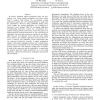Free Online Productivity Tools
i2Speak
i2Symbol
i2OCR
iTex2Img
iWeb2Print
iWeb2Shot
i2Type
iPdf2Split
iPdf2Merge
i2Bopomofo
i2Arabic
i2Style
i2Image
i2PDF
iLatex2Rtf
Sci2ools
DATE
2008
IEEE
2008
IEEE
Wire Sizing Alternative - An Uniform Dual-rail Routing Architecture
To achieve minimum signal propagation delay, the nonuniform wire width routing architecture has been widely used in modern VLSI design. The non-uniform routing architecture exploits the wire width flexibilities to trade area for performance. However, many additional design rules, which confine the routing flexibilities, are introduced in nanoscale circuit designs. With the increasing difficulties of fabricating nanoscale circuits, the conventional nonuniform routing architecture becomes clumsy. We propose an uniform dual-rail routing architecture to cope with these new challenges. The proposed architecture exploits the anti-Miller effect between two adjacent wires with the same signal source. Hence, the coupling capacitance between these two wires is reduced. The simulation results demonstrate that our proposed architecture provides a signal propagation channel with similar propagation delay, less crosstalk noise, and less power consumption to the conventional non-uniform routing ...
DATE 2008 | Dual-rail Routing Architecture | Hardware | Non-uniform Routing Architecture | Routing Architecture |
| Added | 29 May 2010 |
| Updated | 29 May 2010 |
| Type | Conference |
| Year | 2008 |
| Where | DATE |
| Authors | Fu-Wei Chen, Yi-Yu Liu |
Comments (0)

